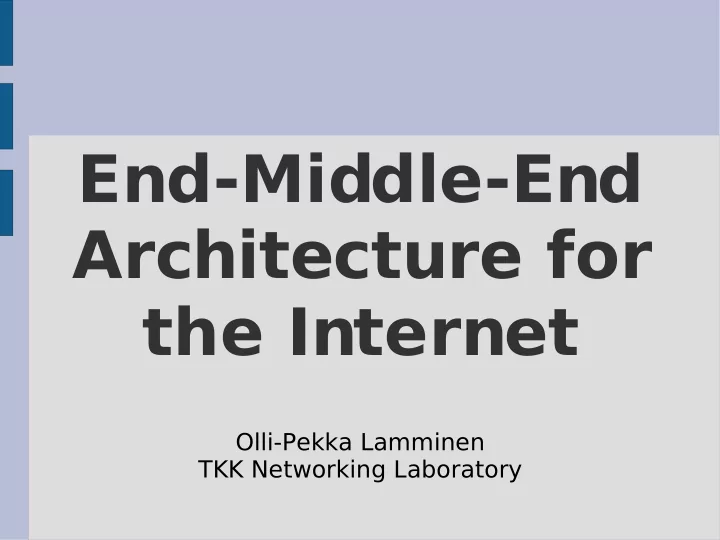

End-Middle-End Architecture for the Internet Olli-Pekka Lamminen TKK Networking Laboratory
Outline ● End-Middle-End Architecture ● IRTF EME Research Group – Requirements ● NUTSS – Architecture – Feasibility ● Considerations for EME Architectures ● Future Work ● References
End-Middle-End Architecture ● Middleboxes have changed Internet – End-to-end traffic model has been broken – Firewalls, NATs, etc. ● Middleboxes need to be included in connection establishment – Endpoints should be aware of middle – Endpoints need means to request services
IRTF EME Research Group ● IRTF Established EME RG in 2006 – Set of requirements for EME architectures ● Common naming ● Flow redirection – globally-unique – endpoint > endpoint – long-term stable – middlebox > endpoint – user-friendly – mobile rerouting ● Access control policies ● Protocol negotiation ● 2-way authentication ● Multi-homing ● Multicast – endpoint <> middlebox ● Information protection ● Fast flow initiation – anonymity – optimally 1 st packet – encryption contains data ● Middlebox discovery ● Incremental – when allowed deployment
NUTSS Architecture ● EME compatible architecture – Created by people behind IRTF EME RG ● Policy-aware edge networks connected to policy-free core ● Edge nets have P-Boxes and M-Boxes – P-Box: controls network policies ● form a tree-like hierarchy ● used during name-routed signalling – M-Box: ' regular' middlebox ● just like middleboxes today (NAT, firewall, ...) ● handles data flows ● Endpoints register to P-Boxes
NUTSS Architecture [naming] ● Stable, user-friendly naming – location-independent – 3-tuple (user, domain, service) ● user: not globally-unique, identifies user ● domain: globally-unique, hierarchical DNS name ● service: globally-unique service identifier – Mapped to 5-tuple address during connection establishment ● Assumes the presence of DNS
NUTSS Architecture [name-routed signalling] ● Used to create path for data flow ● Signalling traverses through P-Box tree – Up until core – Down to endpoint ● P-Boxes add next- hop tokens – Tokens used for address routing
NUTSS Architecture [address-routed messages] ● Data flows through M-Boxes ● Routing by next- hop tokens ● Endpoint addresses given during name- routing
NUTSS Feasibility ● Fulfills many IRTF EME requirements – Mobility by short-lived addresses and rapid renegotiation – Multi-homing from location independence – Multicast with extended naming ● 3-tuples changed 4-tuples ● Performance may be an issue – Lots of signalling overhead – Payload in 1 st packet not possible ● Deployment strategy at draft-stage – Which is OK
Considerations [naming] ● Users want user-friendly names ● Names should be if not globally-unique at least scope-unique – Uniqueness requires coordination – Coordination requires authority (NS) ● Mobile endpoints will be commonplace – Changing location requires updating NS – Network registration helps mobility – Registration and updates require authentication
Considerations [middleboxes] ● Middleboxes are already commonplace – Home routers, web proxies, ... ● Endpoints should be aware of them – Awareness enables flexibility – NAT traversal, firewall control, ... ● Middleboxes need means to advertise ● Endpoints need means to request ● Endpoints should be able to trust middleboxes and vice versa – Service authentication is required
Considerations [trust] ● Trust needs to be provided – Joining network – Name and location updates – Middlebox services ● Who trusts whom? – Endpoints vs. Endpoints – Endpoints vs. Networks, Middleboxes – Between the networks – Inside a network ● Who provides the trust? – Trust relationships between operators – 3 rd party trust authorities
References ● IRTF EME Research Group – [http://www3.tools.ietf.org/group/irtf/trac/wiki/EME] ● NUTSS – [http://www3.tools.ietf.org/group/irtf/trac/wiki/EME_NUTSS] – An End-Middle-End Approach to Connection Establishment Guha & Francis: In Proceedings of SIGCOMM'07 ● Middleboxes – Rethinking the Design of the Internet: The End-to-End Arguments vs. the Brave New World Blumenthal & Clark: ACM TOIT, vol.1, no. 1, Aug. 2001 – Middleboxes No Longer Considered Harmful Walafish et al.: In Proceedings of OSDI'04
End-Middle-End Architecture for the Internet Questions?
Recommend
More recommend